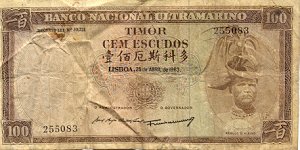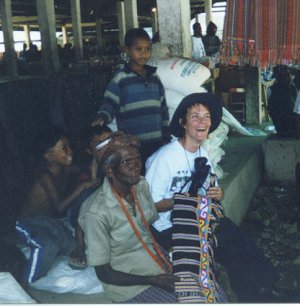

|
DILI, March 2001.
SEEING EVERYTHING IN EAST TIMOR being set up from scratch makes me realise how many systems we inherit and take for granted. Here, basics, like what language will be taught in school and used for government documents, as well as what currency to trade with, must be defined.
There are some 34 indigenous languages in East Timor. While many rural people only speak the language of their area, Tetun (tet toon) is the most common local language and would have to be the front runner for official language status. But Tetun hasnít really emerged from the 19th century. It works for conversation, but it doesnít have the technical vocabulary needed for politics, sciences or electronics.
An alternative is Portuguese, East Timorís traditional colonial language. It is the language of choice for many older Timorese, especially those who did their university training in Lisbon. It is these old boys who have scooped the ministerial positions in the interim government. They are pushing for Portuguese as it would certainly help secure them into the power structure. Younger people, for the most part, donít speak or see the point of Portuguese.
Bahasa Indonesia is the most widely understood language in East Timor. For 25 years, all schooling and administration was in Bahasa Indonesia and realistically everyone who speaks more than their indigenous language, speaks it. This is exemplified by the fact that at conferences and courses, the proceedings are always translated into Bahasa Indonesia. But while it is a practical solution to East Timorís language dilemma, it is the language of oppression and many people wonít speak it unless all else fails. Those who support Bahasa Indonesia as an official language are branded as pro-Indonesian, which is like saying nasty things about their mother.
A fourth possibility is English. It is the language of the UN and having some English skills is a requirement to get a government job, or just about any job, for that matter. Australia is aggressively promoting English and I reckon there are more Aussie English-as-a-Second-Language teachers here than boys selling cigarettes in the market. It can be reasonably argued that English is Australiaís late run at colonising East Timor. Young people here see English as their link to the rest of the world and are enthusiastic to learn it. Downsides are that, at the moment, hardly any Timorese speak it fluently, and its value in government may well diminish as the UN scales down its presence here.
The envelope please. And the winners are Ö Tetun and Portuguese.
Another biggie is the currency. During Portuguese times they used the TImorese escudo and you can still find these for sale as sourvenirs. The Indonesians invaded with their rupiah. The US dollar is the currency of the interim government. And a wild card, the Australian dollar, is widely used.

The escudo has all but disappeared. Iíve only ever seen people getting them over the counter at the Banco Nacional Ultramarino through which Portugal pays pensions.
The Indonesian rupiah is the common currency of the Timorese. It is used in the markets and in the majority of shops and local eating places. I use rupiahs for all my day to day needs like bemos and taxis, eating lunch, buying groceries or film, bike repairs, second hand shirts in the market. But like Bahasa Indonesia, the rupiah is immensely practical, but politically unpalatable.
About a third of the time I use Australian dollars. But if you shopped exclusively at the Australian owned Hello Mister supermarket and didnít use the Dili market or little warungs to eat at, as many malaes donít, you would never need to bother with rupiahs.
The American dollar is like the English language option. It is the currency of the UN and like most of the career UN workers, is far removed from the Timorese people. Hotels and many of the more upmarket restaurants are priced in US dollars but all the shops use rupiahs or Aussie dollars. I donít know where these UN people spend their big US dollars pay packets. My guess is that most of the UN money goes directly back to whatever country the worker came from without even landing in East Timor.
The fact is that any of the above three currencies work in most circumstances. Iíve often had meal out with friends and the bill gets paid in Rps, $A and $US. Messy, but itís all money.
 And with three active currencies, there is plenty of scope for confusion. On a trip to Suai, we stopped at Ailieu (al lee oo) where one of my friends began negotiating with an old man for a tais, a traditional Timorese weaving. The seller quoted a dollars amount in Portuguese. Trying to clarify, Emma responded with a rupiah amount attempted first in Tetun then in Bahasa Indonesia. Soon there were 20 people crowding around, some trying to be helpful, others just wanting to be near the action. Finally someone produced a calculator and Emma and the man settled on a visual dollar amount. But when she produced Australian dollars, the man looked at these plastic notes with alarm, as though he had never seen one before. He had been talking US dollars. So the negotiation resumed and by the time Emma tucked her tais under her arm, she had had to find a money changer and turn her $A into rupiah. Everyone knows what the rupiah is worth. If youíre wondering, itís 5000Rp to 1A$. The New Zealand dollar is unknown, here, but if it was, it would be about 4000Rp.
And with three active currencies, there is plenty of scope for confusion. On a trip to Suai, we stopped at Ailieu (al lee oo) where one of my friends began negotiating with an old man for a tais, a traditional Timorese weaving. The seller quoted a dollars amount in Portuguese. Trying to clarify, Emma responded with a rupiah amount attempted first in Tetun then in Bahasa Indonesia. Soon there were 20 people crowding around, some trying to be helpful, others just wanting to be near the action. Finally someone produced a calculator and Emma and the man settled on a visual dollar amount. But when she produced Australian dollars, the man looked at these plastic notes with alarm, as though he had never seen one before. He had been talking US dollars. So the negotiation resumed and by the time Emma tucked her tais under her arm, she had had to find a money changer and turn her $A into rupiah. Everyone knows what the rupiah is worth. If youíre wondering, itís 5000Rp to 1A$. The New Zealand dollar is unknown, here, but if it was, it would be about 4000Rp.
I donít believe the which-currency issue is even on an agenda, yet in East Timor. The country has no reserves and could not credibly operate a reserve bank. If the World Bank agreed to underwrite a state bank here, the government may as well hand just over the finance portfolio to them. Most people agree that the three-currency system works. Eventually having their own currency will become a matter of pride for the East Timorese. But at the moment, this country canít afford its own currency.
There is no doubt people would prefer the government to concentrate on providing them with corrugated iron so they can replace the tarpaulin roofs of their houses than concern themselves with the currency issue.
